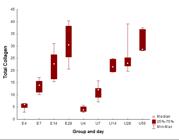ABSTRACT
PURPOSE:
To compare fibroplasia and the resistance of the abdominal wall when polypropylene meshes and polypropylene/poliglecaprone are used.
METHODS:
Seventy-seven male Wistar rats were divided into three groups: Control Group (for resistance); Group E (polypropylene mesh); and Group U (polypropylene/poliglecaprone mesh). The animals in Groups E and U had a standard muscular and aponeurotic defect, with integral peritoneum, and correction with the mesh. Measurements were taken 4, 7, 14, 28 and 56 days after surgery. The resistance, and collagen density were studied.
RESULTS:
Resistance on the 56th day was similar in both meshes. The gain in resistance described an ascending curve for the polypropylene mesh and was irregular in the case of the polypropylene/poliglecaprone. Fibroplasia showed a gain in type I and type III collagen in both groups (p<0.001). Collagen III stabilized in the 14th day and collagen I continued to ascend.
CONCLUSIONS:
The gain in resistance of the polypropylene mesh is regular and ascending, whereas the polypropylene/poliglecaprone is not regular. The final resistance of both meshes is similar; the collagen density increases over time, and show the same inflammatory potential.
Key words:
Surgical Mesh; Hernia, Ventral; Wound Healing; Collagen; Rats

 Thumbnail
Thumbnail
 Thumbnail
Thumbnail

 NOTE: Comparative Mann-Whitney Test between the groups4th day: p=0.093; 7th day: p=0.394; 14th day: p=0.628; 28th day: p=0.699; 56th day: p=0.202
NOTE: Comparative Mann-Whitney Test between the groups4th day: p=0.093; 7th day: p=0.394; 14th day: p=0.628; 28th day: p=0.699; 56th day: p=0.202